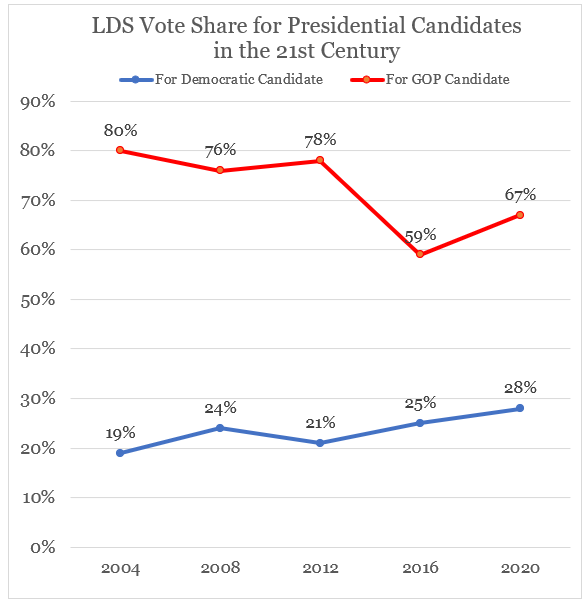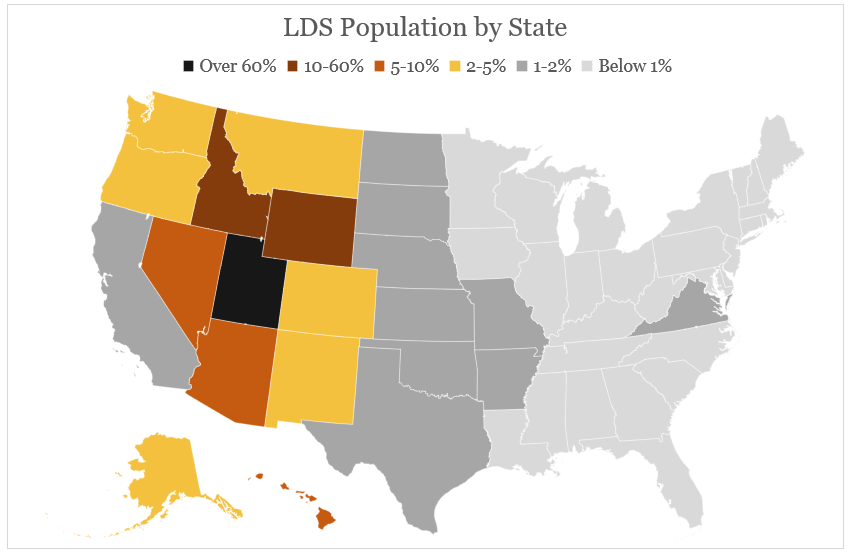
Democrats Ignore Mormon Voters at Their Peril
Donald Trump won two-thirds of Mormon voters in the 2020 election. This was up from just shy of 60% in the 2016 election when third party candidate Evan McMullin sapped a large share of Latter-day Saints’ (LDS) votes away from Trump and Hillary Clinton performed better among the group than any Democrat in the 21st century. But, Trump’s large margin from voters of this faith in 2020 obscures a more surprising story: Joe Biden won Mormons under the age of 40.
It’s more than that though. Nonwhite members of the Church also went for Biden over Trump. And Biden got 38% of the vote in Utah, a predominantly Mormon state, which was better than any Democrat since Lyndon B. Johnson – who won the state with 55% of its vote. Overall, Biden’s performance among LDS voters in 2020 represents a recent apex in two broad shifts in voter behavior and in Democrats’ electoral efficiency in the Southwest.
Romney-Biden Voters?
If you were to separate their religious affiliation from their demographics and squint a little, members of the Church of Jesus Christ of Latter-day Saints look like a key part of the emerging Democratic coalition: they are slightly younger than the general population, over 60% of them have some college education (compared with around 50% of the general population), a majority of them are women, and they’re predominantly middle class. To say these demographic traits decided the 2020 election is an understatement. Viewed through this lens, LDS members would be a key component of future Democratic coalitions trying to recapture the anti-Trump vote in 2020 by leveraging suburban, educated voters in an electoral rebuke to Trump’s blasphemy.

About 86% of Mormons are white, compared to just 71% of the US population. And ideologically, Mormons share much in common with white evangelicals in the country – or at least, they did. Though they poll evenly on policy preferences on firearms, Mormons are less willing to support making abortion completely illegal and more prone to support exceptions in cases of rape, incest, or life of the mother. On immigration, Mormons are far more liberal that evangelicals, with 71% supporting President Obama’s Deferred Action for Childhood Arrivals policy, and the church loosely follows a “don’t ask, don’t tell” policy in regards to baptizing, promoting, and supporting illegal immigration in the United States. Mormons are also more likely to favor increased immigration than most other religious groups in America. This unexpected boon has been theorized to originate from an emphatic tradition in the church: serving as missionaries.
Because many young men in the faith are encouraged to serve on a full time, two-year proselytizing mission, and approximately 30% of 19-year-old male members serve as missionaries, there is a diaspora of LDS members across the globe and within the United States. As of 2007, 80% of all missionaries were young, single men; 13% were single women, and 7% were retired couples. Many missions serve non-proselytizing humanitarian purposes, and even those that don’t are asked to perform several hours of community service per week. Anecdotally (though also through some limited research, both in support of and against this conclusion), it seems intuitive that travel would broaden worldviews, decrease “othering,” and expose travelers to circumstances different than their own or what they are used to. This tracks with some other research indicating that growing up sharing a neighborhood with a different race makes people more liberal, that increased diversity in classrooms leads to education-enhancing outcomes, and that “mere exposure” to people who are different than you tends to increase positive attitudes towards different people.
Beware of False Prophets
The Mormon faith saw in Trump’s anti-Muslim rhetoric a scene familiar in their own persecuted history. They were embittered by Trump’s criticism of former Republican presidential nominee Mitt Romney, who is Mormon. And unlike many evangelicals, Mormons were unable to uniformly ignore Trump’s character traits of unvirtuous vulgarity and infidelity. But there’s also something larger – the church places unique emphasis on institutionalism and the rule of law compared to many other religious sects.
The church adopted the “Articles of Faith” written by Mormonism’s founder, Joseph Smith, as scripture. Article 12, which reads “we believe in being subject to kings, presidents, rulers, and magistrates, in obeying, honoring, and sustaining the law,” asserts support for the church’s existence within and under a governed society. There is even a belief by LDS members that the United States Constitution was a divine miracle. Calls for “civic virtue” and for “law-abiding citizens, supportive of national, state, and local governments” have been touted by LDS scholars while they stressed the need to oppose infringement on the founding principles of America’s government. As both candidate and president, Trump’s disregard for the basic tenets underpinning the rule of law in the United States caused an institutional backlash, and it’s not hard to see why that would rub the church the wrong way. Whereas many evangelicals, which flocked to Trump as a savior offering redemption and wealth, found themselves able to fit Trump into their narrative, the Mormon church eschewed the notion that any one man can be above their core principles.
Take another institution of great reverence in America: the military. Often misjudged as predominantly conservative (the armed forces aren’t particularly disproportionate from the nation overall, though they are more male-dominated and diverse than the nation at large), there was a documented electoral backlash against Trump by those in and around the military ecosystem in the 2020 election. Regimented, adherent, and a respect for doctrinal leadership are all traits that define strong organized religions and the armed services. It’s no surprise that Mormonism, a particularly strong religion both regionally and institutionally, would fit that mold.
For this is Zion
The shifting inclinations of the Mormon faith that came to the forefront in the 2016 and 2020 elections paralleled that of the Democratic Party’s own electorate. Educated, devout, and concentrated in a region of electoral importance, their voting bloc is critical in several swing states, and they are more open to voting for Democrats than assumptions based on the early part of the century may portend.
We’ve made the case before on this site that Democratic success in the 21st century is dependent on the party taking note of the headwinds in their party’s past electoral successes and the opportunities revealed by the new Republican Party. In our series last year on the decline of Democratic strength in the Midwest, we concluded that Democrats should pivot away from where they are in decline to expand on their new opportunities in other regions. We noted that “if Democrats spend their time desperately grasping for these Midwestern states back, they will do so at the peril of states where their party now resonates, which represent a diverse tapestry of their party’s urbanites, college-educated, non-white constituents. The Sun Belt’s opportunities aren’t as homogenous as those in the Midwest, but neither is the Democratic Party.”
If the Democrats learn the lessons of the 21st century and read the writing on the wall (a big ask, admittedly, for a party that seems reluctant to eschew the region), they should seek to shift their electoral strategy and base away from the Midwest and towards the South and the West. The changing behavior of Mormon voters makes an excellent case as to why.
Members of the church compose more than 5% of the population in two key swing states: Arizona and Nevada. Crudely extrapolating based on statewide data, there are roughly 190,000 LDS voters in Arizona and roughly 80,000 in Nevada. In the 2020 election, Arizona went for Biden by a margin of under 11,000 votes; Nevada by a margin of under 34,000 votes.
Though Biden would have still won Nevada without a significant share of the LDS vote (our model estimates he could have won as low as 6% and still won the Silver State), he would not have won Arizona had he received less than 26% of the national LDS vote – which is still more than any other Democrat has received in the 21st century (Clinton, the second-best performance among LDS voters by a Democratic presidential candidate, got 25% in 2016 compared to Biden’s 28% in 2020, see chart above).

And while Utah remains a longshot for Democrats, Biden’s surprising overperformance there is something to keep an eye on if LDS voters remain squeamish about the modern Republican Party, especially if the majority of younger Mormons continue to support Democrats. As noted earlier, members of the faith are younger than the country overall. What’s more, the faith is one of the select few in the country that is still growing.
In an increasingly secular nation where fewer than 50% of the public are members of a church and “nothing-at-all”s are the fastest growing “religious” identity, the Church of Jesus Christ of Latter-day Saints has nonetheless grown. In data from 2011, it outperformed the other ten largest Christian religions in the United States (many of whom shrank) in growth. It has been touted as the fastest-growing religion in the country thanks to their missionary efforts, religious appeal, and strategic outreach. As other parts of the future Democratic electorate emerge such as suburban voters, voters of color, college-educated voters (all of which, like Mormons, are growing), Democrats and Republicans would both be wise not to take Mormon voters for granted.
And that brings us back to where we started. Mormons have demonstrated that they are open to persuasion, and not particularly keen on the turn the Republican Party has taken in the last ten years – a far cry from when their own Romney was the GOP standard bearer. Young Mormons increasingly look leftward politically and their population at large shares much in common with the Democratic base. 2016 and 2020 demonstrated that they are a more malleable part of the electorate than expected. Democrats should take note and stop shrugging them off.